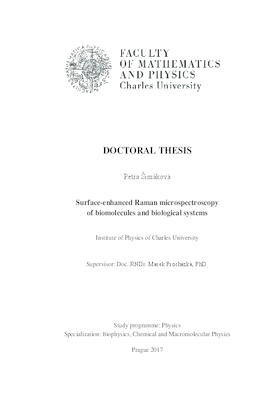Surface-enhanced Raman microspectroscopy of biomolecules and biological systems
Surface-enhanced Raman microspectroscopy of biomolecules and biological systems
dissertation thesis (DEFENDED)

View/
Permanent link
http://hdl.handle.net/20.500.11956/91668Identifiers
Study Information System: 76064
Collections
- Kvalifikační práce [11325]
Author
Advisor
Referee
Michl, Martin
Šloufová, Ivana
Faculty / Institute
Faculty of Mathematics and Physics
Discipline
Biophysics, Chemical and Macromolecular Physics
Department
Institute of Physics of Charles University
Date of defense
21. 9. 2017
Publisher
Univerzita Karlova, Matematicko-fyzikální fakultaLanguage
Czech
Grade
Pass
Keywords (Czech)
SERS, Raman microspectroscopy, colloidal nanoparticles, porphyrins, FON, biotemplatingKeywords (English)
SERS, Ramanova mikrospektroskopie, koloidní nanočástice, porfyriny, FON, biotemplatingCílem této práce bylo využití mikrospektroskopie povrchem zesíleného Ramanova rozptylu (SERS) ke studiu biomolekul a biologických systémů. Hlavní testovací molekulou byl kationický porfyrin H2TMPyP, avšak byly použity také jiné porfyriny, tryptofan a dva lipidy. Byla srovnána citlivost a reprodukovatelnost několika pevných SERS substrátů: (1) Au a Ag nanočástic (NPs) imobilizovaných pomocí bifunkční molekuly, (2) AgNPs imobilizované vyschnutím, (3) vysoce uspořádaných Au- a AgFON substrátů a (4) Ag pokovených hmyzích křídlech. Na většině z těchto pevných povrchů byla nejnižší detekovaná koncentrace H2TMPyP ~10-8 M. Nejvyšší citlivost poskytly vyschlé kapky směsi AgNPs/analyt, z nichž byly detekovány koncentrace 1×10-10 M TMPyP, 1×10-5 M tryptofanu, 2×10-7 M DSPC a 3×10-7 M DMTAP. Spektrální reprodukovatelnost je však v tomto případě nižší kvůli metalaci porfyrinu a změnám ve spektrech lipidů ve srovnání s jejich Ramanovy spektry z roztoku. Nejvyšší reprodukovatelnost byla dosažena na AuFON substrátech a Ag pokovených hmyzích křídlech. AgNPs modifikované polymerem PEG byly testovány na rakovinných HeLa buňkách pro vnitrobuněčné využití. Metalace H2TMPyP sloužila jako sonda dostupnosti povrchu PEG-Ag- nanočástic. Výsledky prokázaly, že tato dostupnost je závislá na chemických vlastnostech jak...
The aim of this thesis was using surface-enhanced Raman scattering (SERS) microspectroscopy for the study of biomolecules and biological systems. The main probe molecule was cationic porphyrin H2TMPyP, however, other porphyrins, tryptophan and two lipids were also used. The sensitivity and reproducibility of several solid SERS substrates: (i) Au and Ag nanoparticles (NPs) immobilized via a bifunctional linker, (ii) AgNPs immobilized by drying, (iii) highly ordered Au and Ag film-over-nanosphere (FON) and (iv) Ag-coated insect wings were compared. On most of the solid substrates, the lowest detected H2TMPyP concentration was ~10-8 M. The highest sensitivity was provided by the dried drops of AgNPs/analyte mixture, where concentrations 1×10-10 M TMPyP, 1×10-5 M tryptophan, 2×10-7 M DSPC and 3×10-7 M DMTAP were detected. Nevertheless, the spectral reproducibility was decreased due to porphyrin metallation and perturbation of the lipid spectra in comparison to their Raman spectra from solution. The highest reproducibility was achieved by AuFON and Ag-coated insect wings. Finally, the AgNPs modified by PEG polymers were tested for intracellular application using HeLa cancer cells. Metallation of H2TMPyP served to probe the accessibility of PEG- AgNPs surface. The results proved that the accessibility...
